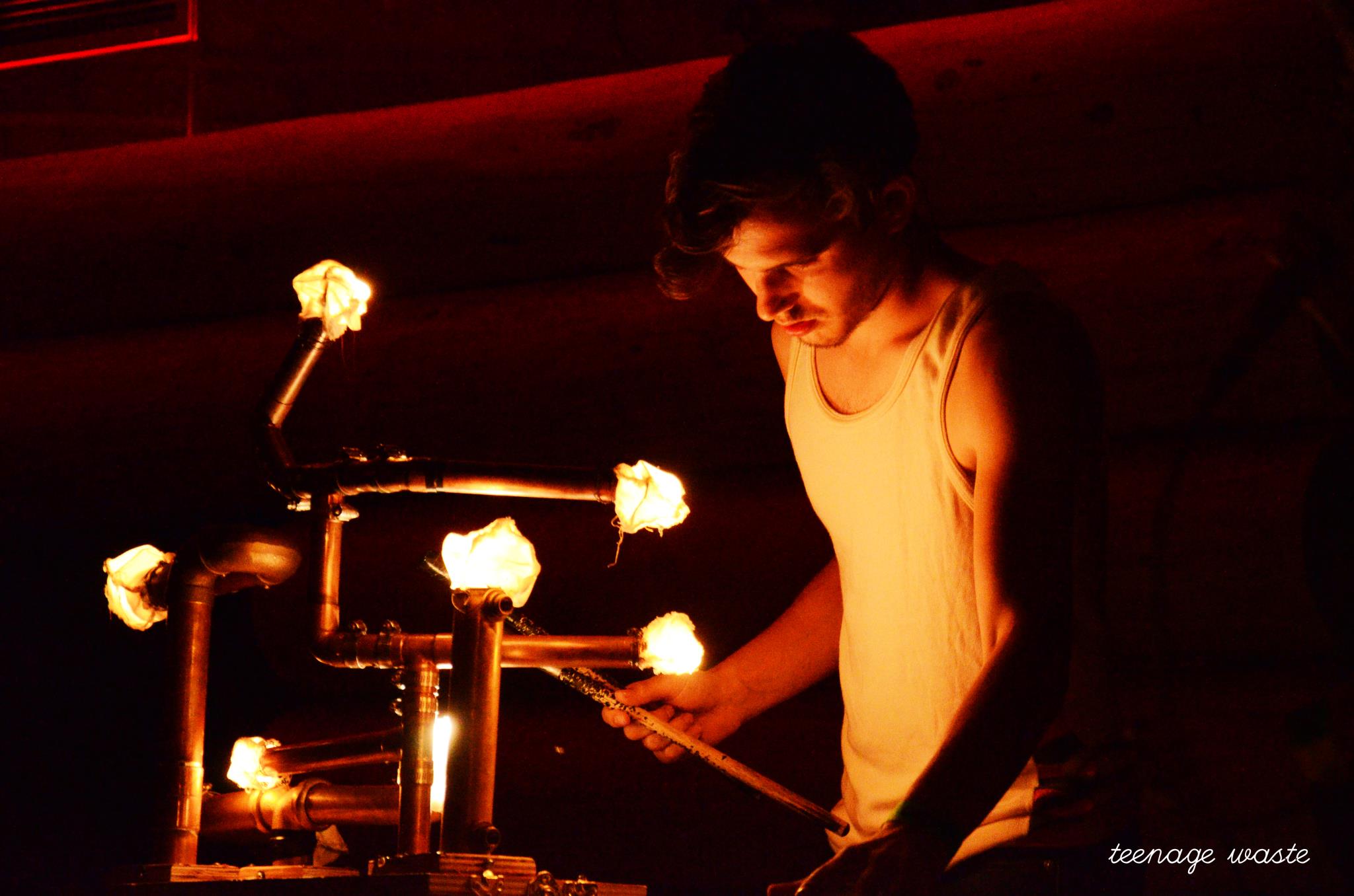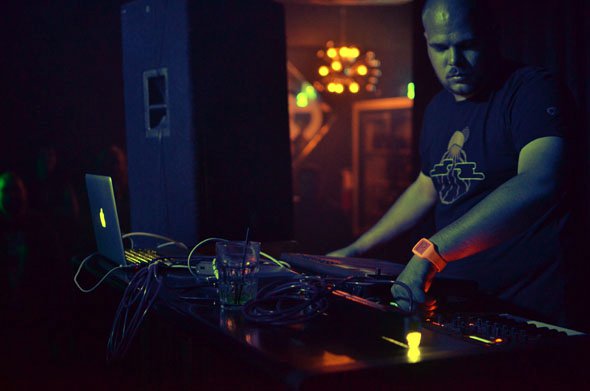Following up on our own recommendations
Saturday, 10/1

Purity Ring
Whatever this much-hyped, little-understood band was going to do, it was bound to be a surprise. Until recently, the Canadian duo hid from the media remarkably well (indeed, I didn’t even know they were a duo until maybe a month ago) while their gradually trickling material – surreal, genre-baffling pastiches of dub step, fragmented pop and nursery rhymes – stoked critics and earned them a coveted tag in today’s oft-lamented “retromaniac” hipster culture: future pop.
How to even produce the sounds on “Ungirthed”, “Lofticries” and “Belispeak” was incomprehensible to me, going in. In short, the band left little room for expectations.
So little, in fact, that when an unimposing couple – one lanky, bespectacled dude who looked like everyone else in the audience and a pocket-sized goldilocks by his side – took the stage, it did not occur to me that they might be Purity Ring. That is, until they signaled to the tech people to cut the lights – all of them – and produced their own meager and somewhat unsettling sources of illumination: a large upright drum, lit dimly from within, an anemone-like lamp fixture and a flickering mining lantern.
It looked, appropriately, like we were in for an incantation.
Amazingly, the band reproduced their songs – the three released tracks, plus three others – almost to a T. Somehow, what looked like random knob tinkering and percussive whacking (the usual causal intransparency inherent in electronic performance) resulted in all the recorded work’s sputtering snares, demonic echoes and the chopped-to-bits fragmentation of singer Megan James’ chirping vocals.
This was both a delight and a disappointment. As thrilling as it was being hit with an unblemished “Ungirthed” in a live setting where, without the smoothing glaze of studio production, each component of the song could assert itself more independently, it would have been cool to see the building process in action, even if this were to mean a more rough-around-the-edges rendition.
Purity Ring’s sound clearly wasn’t for everyone, but the band definitely compelled a select cohort to groove, or at least attempt to (dancing to Purity Ring is like dancing to your standard, Brittney Spears-esque pop after taking a few big huffs of something potently dissociative).
For me at least, this was a strange and exhilarating bodily experience, and one of the night’s highlights.

By the time Com Truise came on, most of the audience had turned out and the small box that is The Rickshaw Stop was getting pretty humid. People were pumped for Com, too; based on the giddy conversation snippets I overheard in the minutes preceding the band’s set, I even got the feeling that a sizable chunk of the audience had in fact come for this retro-futurist synthmonger, rather than the headliner. The rapidity at which the venue cleared during Neon Indian’s encore further testifies to Com Truise’s share of precedence.
For me, Com Truise was due to be another surprise. While, admitted Tom Cruise fan that I am, I found the album art on Com Truise’s Cyanide Sisters EP humorous and graphically awesome enough to serve as my laptop background for a few weeks following its release, somehow I never got around to actually listening to any of it.
Boy, do I not regret that. Com Truise unleashed a more or less unbroken flow of tepid, single-textured and gelatinous synth, laid politely over conventional, grid-following pulse.
It is what I would call vacuum music: not only does it provoke no particular feeling (apart from whatever fond associations you already had with the videogame/80s sci-fi effects the songs are drenched in) or thought, but it is loud and immersive enough to actually forbid them, leaving only the option to slip into a trancy zone and bob your head like a square white guy (“Brokendate,” “VHS Sex” – taking 80s fetishism to a whole new level).
I, along with most of the audience, succumbed (though I think it’s safe to say I was more bitter about it). I won’t pretend to gripe about the performance; truthfully, I wouldn’t know what to gripe about (well, we might have been spared the perfunctory-hinting-at-disingenuous audience interaction; “good to be in San Francisco. My … favorite city” – is it really?)
Frankly, it’s a shame Com Truise was sandwiched between such great stuff. Had the show been scheduled otherwise, I would have arrived late or left early.

Rewind just two years and you’ll catch Alan Palomo at this same venue, hunched over a soundboard and looking very much a pudgy, even slightly morose 21-year-old struggling under the weight of “Neon Indian” – his funky, cassette tape-inspired bedroom project that had so suddenly become the next big thing.
He didn’t say much at that show. Clearly unsure both of himself as a stage performer and of his band’s capacity for support, Palomo focused his energy on making sure he got every little thing right – every warp, blip, and hook in its proper place. Of course, the show fell flat.
What a transformation has taken place.
At Saturday’s show, Palomo owned the stage with a self-assurance and exuberance rare even in performers years his senior. Swinging his lower half while gripping and dipping the mic stand in his boots, tight grey jeans and rolled-up shirtsleeves, this son of a Mexican pop star looked very much like he had grown into his inheritance.
More importantly, though, this time it was more than just Alan Palomo and the Neon Indians on stage. “We are Neon Indian,” he announced. Indeed, the 5-piece functioned marvelously as a whole, each member carrying equal parts of a song so Palomo could fly from lead vocalist to knob-destroying techno-genius and back, and have fun doing it.
Neon Indian is touring in support of their sophomore release, Era Extraña, a stormy consideration of love and relationships in an era that is “future sick.” A melancholy-tinged work even amidst its thicket of pop hooks (“Polish Girl,” “Hex Girlfriend,” “Halogen (I Could Be a Shadow),” “Future Sick”), it stands in stark contrast to the sunnier, less disillusioned youthfulness of Psychic Chasms jams like “Deadbeat Summer,” or “Terminally Chill”.
So when Palomo emerged in high spirits, unfussed with any theatrical pretensions of embodying the mood of the album (he joked frequently, chalking up his exuberance to the shrimp burrito he had for dinner), it was as though a thought-to-be-ailing Willy Wonka had just somersaulted to the gate.
The band altered their songs slightly, rendering Psychic Chasms tracks a little grittier and Era Extraña tracks a little sunnier. Neon Indian is certainly adult now, but, as the performance made clear, they have no intention of strangling the fun out of their earlier work.
Do not miss them next time they come around.
Sunday, 10/2

A confluence of factors pointed to Sunday’s show sitting mellow, maybe even lackluster, in the wake of the previous night’s excitement: it was a school night, meaning noise restrictions and, hence, an early-bird show (the first band started promptly at 8 pm; Toro Y Moi left the stage at 11 sharp); the opening bands, Bass Drum of Death and Unknown Mortal Orchestra, though decent and at times shining specimens of garage rock and 60s-inspired pop (respectively), were nothing to write home about; the crowd was sparse – enough for me to hear, with unfortunate prominence, the timbre of my own hoots between songs.
Fortunately, once Toro Y Moi completed the intial tour of their prettily melodic but squarely-laced indie rock material (“How I Know,” “Elise”) and began digging into their steadily accreting store of funk jams (“Still Sound,” “All Alone” and everything else on their most recent EP, Freaking Out), the empty space became dancing space and a flailing show gained the steam to wind up a success.
As a matter of fact, the intimate crowd at the Great American proved a lot more loose-limbed than the folks at Neon Indian (I’m gonna go out on a limb and blame Com Truise for this).
By the end we were eager to prolong our Sunday night’s grooving; the audience’s demand for an encore was admirably insistent, and we got one, though meager (One song? Really?)
Toro Y Moi still have room to grow, as performers and as composers. Delighted by their Outside Lands performance on the eve of the promised-to-be-funky Freaking Out, I saw them as full of potential – the potential to unleash the dance appeal that in so much of their material rests just on the brink of exploding, only to bury itself in chill-as-ice production when the right moment arrives.
Freaking Out is certainly a stride in the direction I had hoped for. Still, though full of delicious electronic, funk and R&B components (“Freaking Out,” “I Can Get Love”), it remains regrettably even-tempered. The same can more or less be said for their live show.
This is why, at the end of the day (literally), I found myself in headphones, tearing up the rug in my bedroom – just me, a bottle of Anchor Steam and the victor of the Chillwave Showdown: Neon Indian.
Want more news, sent to your inbox every day? Then how about subscribing to our email newsletter? Here’s why we think you should. Come on, give it a try.









